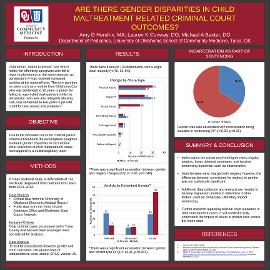| dc.description.abstract | BACKGROUND: Oklahoma’s failure to protect law, which holds non-offending caregivers who fail to report maltreatment to the same standard as perpetrators, has received increased scrutiny at the national level. This is in part due to cases such as Tondalao Hall, a mother from Oklahoma City who was sentenced to 30 years in prison for failing to report child maltreatment while the perpetrator, who was also allegedly abusing Hall, was sentenced to two years in jail with credit for time served and probation. Due to the increased focus for criminal justice reform in Oklahoma the investigators sought to evaluate gender disparities in the criminal court outcomes of child maltreatment cases investigated by a multidisciplinary team.
METHODS: A cross-sectional study was conducted of defendants of 151 medically diagnosed child maltreatment cases from 2013–2014. Data included both clinical data from the University of Oklahoma Electronic Medical Record as well as publicly accessible data from the Tulsa District Attorney’s Office and Oklahoma State Courts Network. Only defendants with criminal cases prosecuted within Tulsa County were considered for analysis. Expunged cases were also excluded from analysis. To test for associations between gender and court outcomes, chi-square tests of independence were used in SPSS, version 25.
RESULTS: There were a total of 138 defendants, with a slightly male majority (n=76, 55.1%). There was a significant association between gender and neglect charges (χ2(1)=3.96, p<0.046), with 46.8% of females charged with neglect vs. 30.3% of males. There was also a significant association between gender and verdict type (χ2(1)=14.35, p<0.001), with a greater percentage of females (43.5%) receiving deferred verdicts than males (15.8%). Conversely, a greater percentage of males (71.1%) received guilty verdicts than females (41.9%). Gender was also associated with incarceration being included in sentencing (χ2(1)=6.63, p<0.01), with a greater percentage of males (56.6%) receiving jail/prison time than females (35.5%).
CONCLUSION: The results indicate that males within the cohort typically received higher rates of guilty verdicts, fewer deferred sentences, and harsher sentencing outcomes, such as incarceration. Notably more females than males were charged with neglect (46.8%); however, the difference between convictions for neglect by gender was not statistically significant. Further research regarding criminal court outcomes in child maltreatment cases is still needed to fully understand the impact of failure to protect laws across the entire state. | en_US |


